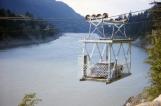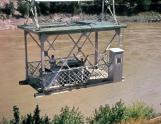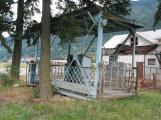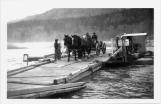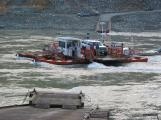

Lytton Museum and Archives
Lytton, British Columbia
1
As much as the story of Lytton is tied to the roads and railways, it is also tied to the rivers that define its location. The following pictures illustrate the various watercraft that were used to cross the rivers. The only crossing still made by ferry is the reaction ferry to the west side of the Fraser just north of the Village of Lytton.2
In 1867, tenders were invited for the right of the ferry route across the mouth of the Thompson River. This was to be the first authorized ferry, with owners allowed to charge for services, between the Government of B.C. and the successful applicants.The tender of a 3-man partnership was accepted, and a contract was drawn up between Constable A.S. Hall, as agent for the Government, and Messrs James S. Anderson, William McWha, and Patrick Kilroy, all business men of Lytton.
The terms of the contract were as follows:
1. An annual rent of one hundred and thirty-five dollars was to be paid in quarterly installments ($33.75).
2. The rates of toll were not to exceed the following:
Passengers with personal baggage $ .50
Man and horse 1.00
Cattle per head .50
Pack trains - each animal .50
Sheep and hogs .25
Freight per 100 lbs .25
3. A good and proper boat for the transport of foot passengers shall be kept and a person for working of the same shall always be in attendance, also a large boat capable of ferrying animals across not less than 6 pack horses at a time. Boats must be kept in good repair.
4. All government officers, government animals and government baggage to be crossed free of charge.
5. Rates to be posted in a conspicuous place.
6. If a bridge is built, ferry owners shall not be entitled to claim recompense, and on completion of the bridge the ferry must cease.
7. Lease started Jan. 1, 1867. Conditions to be strictly adhered to. If in default all boats would be forfeited to the government.
8. The right of the ferry shall extend one mile up the Thompson River from it's mouth, and one-half mile up the east bank of the Fraser River, commencing from boundary lines of Byron Earnshaw ferry on said river.
The Thompson River ferry only operated for 6 years, as the first Thompson River Bridge was built in 1873/4. We have no record of the operating successes or failures of this venture.
3
The early Lytton Ferry. Passengers and freight were carried in the boat across the Fraser River.1900
Lytton, BC

4
The photo at left shows the early Fraser River Ferry at Lytton, but is typical of the Boston Bar-North Bend Ferry that was replaced by the Aerial Ferry in 1940.5
The Boston Bar/North Bend Aerial ferry was installed in 1939 and officially opened on March 15, 1940. It replaced the rowboat crossing on the Fraser River that transported mail as well as passengers to Boston Bar from the CPR on the west side of the river.The Ferry was a steel cage suspended on cables 1,200 feet long. Suspension was 90 feet above low water. The ferry weighed 9 tons and could carry a 3-ton vehicle or 40 passengers. It was originally operated by a diesel donkey, and later by electric power with diesel as a standby in case of power failure.
It was operated by a foreman in the powerhouse (ferry shack) and a deckhand who manned the gates and collected fares when tolls were on. The ferry operated till 6:00 pm, and later on till ll:00 pm.
The cost was 25 cents for a car & driver and 5 cents per passenger, with children riding free. Also, a ticket good for ten trips could be obtained at a cheaper rate.
In later years the ferry was considered as a part of the Highway system and the tolls were taken off. On special holidays such as May Day in North Bend or July 1st in Boston Bar, a group of 20 people attending dances could pay in advance $1.00 for an extra run at 2:30 am, and additional passengers paid 5 cents. If you missed the run you were stranded until the next day.
The ferry cage was only 3 to 4 feet above the Fraser River in the June flood of 1948.
For a short period of time the workers on the ferry were considered as Marine Workers and were issued official Ferry uniforms. The ferry staff were listed as part of the B.C. Government Ferry Fleet.
Then it was brought to the attention of the government that the aerial ferry never touched water, so once again it became part of the B.C. Highway Department.
The ferry cage can be viewed on the Boston Bar side of the bridge just off the Trans-Canada Highway.
9
Although the Thompson Indians of the area had been crossing the Fraser River for many years by canoe or rowboat, the first documented ferry across the Fraser River at Lytton was a private one dating back to 1863.It was built by Byron Earnshaw, an Englishman who, in 1858, joined the gold rush to British Columbia and mined for gold at Texas Bar, below Yale.
He came to Lytton in 1862, married a local girl, Amy Raphael, and proceeded to build his ferry and a small supply store.
11
For a time a reaction scow (a flat bottom vessel with square ends) was used, but large boats of 10m using the reaction principle did most of the ferrying until 1942, when a five-ton capacity wooden boat was put into use.Since that time larger ferries have replaced the preceding one until the present twin 17 metre steel pontoon ferry was put into use.
